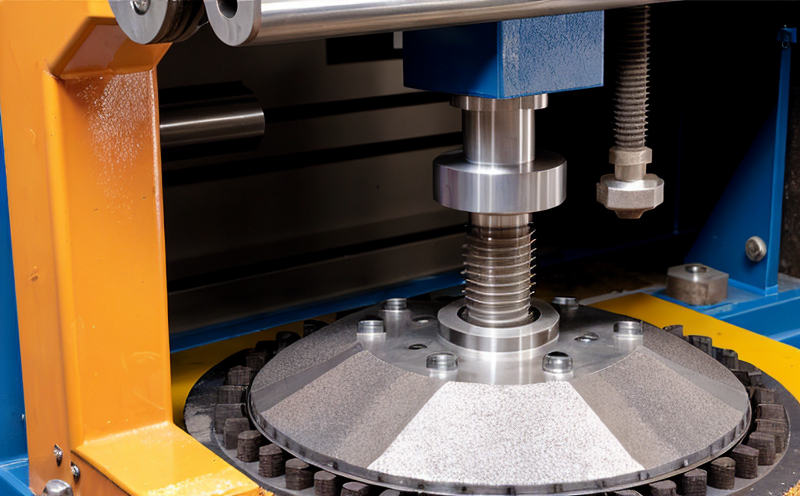ISO 2372 Rotating Electrical Machinery Vibration Test
The ISO 2372 standard provides a method for measuring and evaluating the vibration of rotating electrical machinery. This is critical in ensuring that machines like generators, motors, turbines, and pumps operate within safe performance parameters. The test is designed to identify potential issues such as misalignment, unbalance, or bearing wear before they lead to catastrophic failure.
The ISO 2372 vibration test involves measuring the acceleration levels at various points on the machine shaft. By using accelerometers placed strategically around the machine, we can capture a comprehensive picture of how the machinery is performing under operating conditions. This data is then analyzed against predefined thresholds specified in the standard.
The process begins with thorough preparation of the specimen. The equipment must be correctly aligned and operating at its intended speed. Once running smoothly, the accelerometers are attached to key locations on the machine shafts where vibrations would most likely occur. Data collection typically lasts several minutes during which time the machine is subjected to typical operational conditions.
After collecting raw data from multiple sensors, it undergoes rigorous analysis using software tools compliant with ISO 2372 guidelines. This involves comparing measured values against established criteria for acceptable performance. Any deviations outside these limits indicate areas requiring attention or corrective action.
The results of this testing are invaluable in maintaining optimal operational efficiency and extending the life cycle of expensive equipment. Regular monitoring allows businesses to anticipate maintenance needs before they become critical issues, reducing downtime and associated costs significantly.
In addition to providing essential diagnostic information, these tests help companies comply with industry regulations related to safety and quality assurance standards. Compliance ensures not only regulatory adherence but also enhances brand reputation through demonstrated commitment to high-quality products and services.
By leveraging advanced technology such as ISO 2372 vibration testing, organizations can protect their investments in capital-intensive infrastructure while ensuring long-term reliability and performance. This approach supports continuous improvement initiatives aimed at enhancing overall operational excellence across all sectors involved in mechanical engineering."
Benefits
The ISO 2372 vibration test offers numerous advantages for organizations responsible for maintaining rotating electrical machinery. One key benefit is the ability to detect early signs of wear and tear, allowing for timely intervention before failures occur. This proactive approach helps prevent costly repairs that could arise from sudden breakdowns.
Another significant advantage lies in improved operational efficiency. By identifying imbalances or misalignments early on, companies can make necessary adjustments to optimize performance, leading to better energy utilization and reduced power consumption. Improved mechanical reliability translates directly into lower maintenance costs over time.
Compliance with industry standards is another important aspect of this service. Adhering to recognized protocols like ISO 2372 demonstrates a company’s dedication to quality assurance practices, which can enhance customer confidence and foster stronger relationships within the supply chain. Furthermore, meeting these requirements may open up new market opportunities by showcasing expertise in best-in-class inspection techniques.
Lastly, consistent application of vibration testing promotes safer working environments by minimizing risks associated with machinery malfunctions. Ensuring that critical components function correctly reduces hazards for maintenance personnel and end-users alike.
Industry Applications
| Application | Description |
|---|---|
| Turbines and Generators | Vibration testing is crucial for monitoring large-scale power generation systems to ensure they operate efficiently while meeting stringent safety standards. |
| Electric Motors | The test helps identify issues in smaller motors used across various industries, from manufacturing plants to residential settings. |
| Pumps and Compressors | In this context, the vibration test is essential for evaluating rotating elements within these devices ensuring they meet efficiency and safety requirements. |
| Wind Turbines | The continuous operation of wind turbines makes regular testing vital to avoid unexpected failures that could disrupt energy production. |
| Hydropower Plants | Vibration analysis ensures hydropower plants continue operating at peak performance levels, contributing positively towards sustainable power generation goals. |
Quality and Reliability Assurance
The ISO 2372 vibration test plays a pivotal role in quality control processes by providing objective measures of machine condition. For manufacturers, this service offers valuable insights into manufacturing defects early enough to be corrected before reaching the customer.
In addition to production line checks, field services often rely heavily on ISO 2372 compliance during installation and commissioning phases. This ensures that newly installed machinery meets specified performance criteria immediately upon startup.
For maintenance teams, regular vibration testing forms an integral part of preventive maintenance programs aimed at extending equipment lifespan. It enables staff to plan replacements or repairs strategically rather than reactively after failures have occurred.
The standard also supports research and development efforts by offering a reliable benchmark against which new designs can be compared. Engineers can use the results from these tests to fine-tune prototypes, ensuring they meet all necessary specifications before finalizing product launches.





